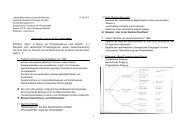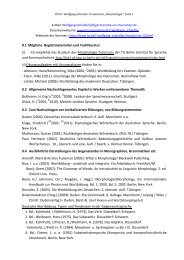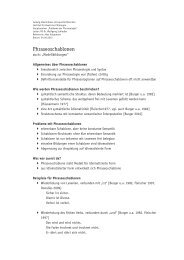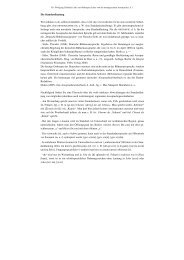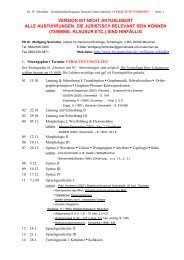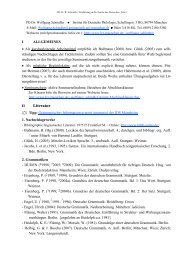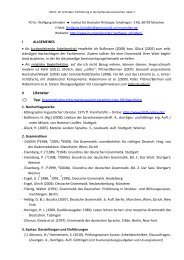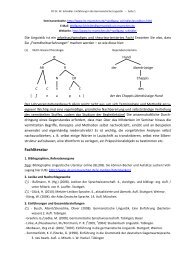Chapter 18 Lexical Functions: Description of Lexical Relations in a ...
Chapter 18 Lexical Functions: Description of Lexical Relations in a ...
Chapter 18 Lexical Functions: Description of Lexical Relations in a ...
Create successful ePaper yourself
Turn your PDF publications into a flip-book with our unique Google optimized e-Paper software.
—<strong>Chapter</strong> <strong>18</strong>. <strong>Lexical</strong> <strong>Functions</strong>— 98<br />
Interest<strong>in</strong>gly, equations relat<strong>in</strong>g the LFs allow for necessary syntactic transformations.<br />
Thus, Rus. On vzjal zverja na mušku lit. (He took the-beast on bead) = (He took aim at the beast)<br />
is reduced to<br />
| ————I II ————————— ↓<br />
ON←I−Labreal 12(MUŠKA)−II→ZVER´ MUŠKA,<br />
which is replaced, us<strong>in</strong>g the dictionary, by the English lexemes as follows:<br />
| ————I II ———————— ↓<br />
HE←I−—Real 1(BEAD)—−II→BEAD BEAST<br />
This DSynt-Structure is readily realized as He drew a bead on the beast. In this way, LFs take<br />
upon themselves even the syntactic adjustments needed to carry out the transfer between<br />
languages—<strong>in</strong> cases where the LFs are implicated.<br />
If, however, the Mach<strong>in</strong>e Translation system under consideration proceeds via a SemR,<br />
then the task (<strong>in</strong> regard to restricted lexical cooccurrence) is to establish the relevant LF start<strong>in</strong>g<br />
from the <strong>in</strong>itial SemR and then to compute its value for the given L, based on a monol<strong>in</strong>gual<br />
dictionary <strong>of</strong> the ECD type. Of course the same procedure is needed for text generation, whatever<br />
its underly<strong>in</strong>g representation.<br />
8.2 LFs and Communicative Structure<br />
The use <strong>of</strong> LFs for an appropriate expression <strong>of</strong> the Communicative Structure <strong>of</strong> the sentence<br />
through its lexico-syntactic structure is dealt with <strong>in</strong> Wanner & Bateman 1990. A detailed<br />
presentation <strong>of</strong> how this could be done requires a description <strong>of</strong> both the Paraphras<strong>in</strong>g System<br />
(Mel’čuk 1992) and Communicative Structure, which is impossible here. Therefore, the reader<br />
has to be satisfied with an example (adapted from Wanner & Bateman 1990). Suppose the text-<br />
generation system has to verbalize the mean<strong>in</strong>g <strong>of</strong> the sentence (21):<br />
(21) a. The adjective ‘electronic’ <strong>in</strong>dicates to the reader that the dictionaries are dedicated<br />
to computers.<br />
If <strong>in</strong> the SemS <strong>of</strong> (21) the mean<strong>in</strong>g <strong>of</strong> the phrase the adjective ‘electronic’ is specified as the<br />
Theme <strong>of</strong> the sentence to be synthesized, then sentence (21)a can be produced. But if the Theme<br />
is the mean<strong>in</strong>g <strong>of</strong> the phrase the reader, a different syntactic structure is needed, which will even-<br />
tually lead to (21)b:<br />
b. The reader gets an <strong>in</strong>dication that the dictionaries are dedicated to computers from<br />
the adjective ‘electronic’.



![E-Mail: Wolfgang.Schindler[ätt]germanistik.uni-muenchen.de Web ...](https://img.yumpu.com/51590147/1/184x260/e-mail-wolfgangschindlerattgermanistikuni-muenchende-web-.jpg?quality=85)
